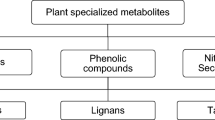Abstract
The changes of lignin and wall-bound ferulic acid induced by wounding were quantitatively and histochemically investigated in the phloem of Chamaecyparis obtusa. Histochemical staining of lignin was first observed in the necrotic region of the phloem 7 days after wounding and developed in 14 days. Increases of the wall-bound ferulic acid and lignin concentrations were detected in the necrotic tissue at 7 and 14 days, respectively. The concentrations continued to increase until 28 days. The lignin concentration of the callus tissue was observed to be lower than that of the healthy tissue at 14 days, and reached a similar level after 28 days. No quantitative changes of lignin and wall-bound ferulic acid were observed in other tissues. The results indicated that lignin synthesis could be maintained after the phloem cells were discolored and seemed to be necrotic. Distribution and timing of the wall-bound ferulic acid and lignin accumulation suggested that the increased wall-bound ferulic acid was involved in the lignin synthesis after wounding.





Similar content being viewed by others
References
Biggs AR (1984a) Boundary-zone formation in peach bark in response to wounds and Cytospora leucostoma infection. Can J Bot 62:2814–2821
Biggs AR (1984b) Intracellular suberin: occurrence and detection in tree bark. IAWA Bull NS 5:243–248
Biggs AR (1985) Suberized boundary zones and the chronology of wound responses in tree bark. Phytopathology 75:1191–1195
Biggs AR (1992) Anatomical and physiological responses of bark tissues to mechanical injury. In: Blanchette RA, Biggs AR (eds) Defense mechanisms of woody plant against fungi. Springer, Berlin Heidelberg New York, pp 13–40
Brignolas F, Lacroix B, Lieutier F, Sauvard D, Drouet A, Claudot AC, Yart A, Berryman AA, Christiansen E (1995) Induced responses in phenolic in two Norway spruce clones after wounding and inoculation with Ophiostoma polonicum, a bark beetle-associated fungus. Plant Physiol 109:821–827
Bucciarelli B, Jung HG, Ostry ME, Anderson NA, Vance CP (1998) Wound response characteristics as related to phenylpropanoid enzyme activity and lignin deposition in resistant and susceptible Populus tremuloides inoculated with Entoleuca mammata (Hypoxylon mammatum). Can J Bot 76:1282–1289
Bucciarelli B, Ostry ME, Fulcher RG, Anderson NA, Vance CP (1999) Histochemical and microspectrophotometric analyses of early wound responses of resistant and susceptible Populus tremuloides inoculated with Entoleuca mammata (Hypoxylon mammatum). Can J Bot 77:548–555
El Modafar C, Tantaoui A, El Boustani E (2000) Changes in cell wall-bound phenolic compounds and lignin in root of date palm cultivars differing in susceptibility to Fusarium oxysporum f. sp. albedinis. J Phytopathol 148:405–411
Franceschi VR, Krokene P, Krekling T, Christiansen E (2000) Phloem parenchyma cells are involved in local and distant defense responses to fungal inoculation or bark-beetle attack in Norway spruce (Pinaceae). Am J Bot 87:314–326
Hatfield RD, Grabber J, Ralph J, Brei K (1999) Using the acetyl bromide assay to determine lignin concentrations in herbaceous plants: some cautionary notes. J Agric Food Chem 47:628–632
Jensen WA (1962) Botanical histochemistry. Freedom, San Francisco
Johnson DB, Moore WE, Zank LC (1961) The spectrophotometric determination of lignin in small wood samples. Tappi 44:793–798
Kang Z, Buchenauer H (2000) Ultrastructural and immunocytochemical investigation of pathogen development and host responses in resistant and susceptible wheat spikes infected by Fusarium culmorum. Physiol Mol Plant Pathol 57:255–268
Klepzig KD, Kruger EL, Smalley EB, Raffa KF (1995) Effects of biotic and abiotic stress on induced accumulation of terpenes and phenolics in red pines inoculated with bark beetle-vectored fungus. J Chem Ecol 21:601–626
Kolattukudy PE (1981) Structure, biosynthesis, and biodegradation of cutin and suberin. Annu Rev Plant Physiol 32:539–567
Kusumoto D, Suzuki K (2003) Spatial distribution and time-course of polyphenol accumulation as a defense response induced by wounding in the phloem of Chamaecyparis obtusa. New Phytol 159:167–173
Lozovaya VV, Gorshkova TA, Yablokova EV, Rumyantseva NI, Valieva A, Ulanov A, Widholm JM (1999) Cold alkali can extract phenolic acids that are ether linked to cell wall components in dicotyledonous plants (buckwheat, soybean and flax). Phytochemistry 50:395–400
Moerschbacher BM, Noll UM, Flott BE, Reisener HJ (1988) Lignin biosynthetic enzymes in stem rust infected, resistant and susceptible near-isogenic wheat lines. Physiol Mol Plant Pathol 33:33–46
Oven P, Torelli N (1994) Wound response of the bark in healthy and declining silver firs (Abies alba). IAWA J 15:407–415
Oven P, Torelli N, Shortle WC, Zupančič M (1999) The formation of a lingo-suberised layer and necrophylactic periderm in beech bark (Fagus sylvatica L.). Flora 194:137–144
Trockenbrodt M (1994) Light and electron microscopic investigations on wound reactions in the bark of Salix caprea L. and Tilia tomentosa Moench. Flora 189:131–140
Vance CP, Kirk TK, Sherwood RT (1980) Lignification as a mechanism of disease resistance. Annu Rev Phytopathol 18:259–288
Woodward S (1992) Responses of gymnosperm bark tissues to fungal infections. In: Blanchette RA, Biggs AR (eds) Defense mechanisms of woody plant against fungi. Springer, Berlin Heidelberg New York, pp 62–75
Woodward S, Pearce RB (1988) Wound-associated responses in Sitka spruce root bark challenged with Phaeolus schweinitzii. Physiol Mol Plant Pathol 33:151–162
Yamanaka K (1989) Formation of traumatic phloem resin canals in Chamaecyparis obtusa. IAWA Bull NS 10:384–394
Author information
Authors and Affiliations
Corresponding author
Rights and permissions
About this article
Cite this article
Kusumoto, D. Concentrations of lignin and wall-bound ferulic acid after wounding in the phloem of Chamaecyparis obtusa. Trees 19, 451–456 (2005). https://doi.org/10.1007/s00468-004-0404-1
Received:
Accepted:
Published:
Issue Date:
DOI: https://doi.org/10.1007/s00468-004-0404-1




